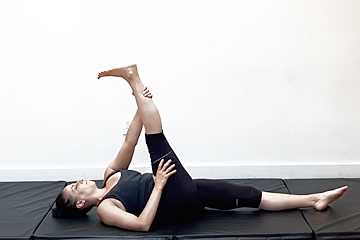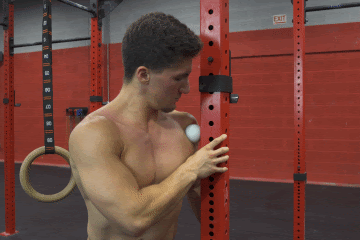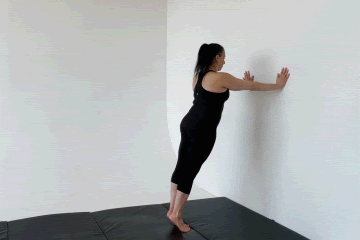Have you ever gone to the gym and felt like your muscles were sore for days after? Well, it’s not just in your head. Muscle soreness is actually a very real thing that happens when you work out. But don’t worry! There are some things you can do to treat sore muscles and as well prevent muscle soreness. Find out what they are below!
Delayed Onset Muscle Soreness
This soreness, known as Delay Onset Muscles Soreness (DOMS), usually begins 24 to 48 hours after the workout and can last for a few days.
This is usually associated with lifting weights after a tough workout or having focused on eccentric contractions in the workout. But it isn’t only exclusive to weight lifters nor eccentrics (although research shows that negative exercise increases the chances).
Calisthenics practitioners, especially when moving into a new workout program, can also experience muscle soreness or doms.
Weekend warriors or even elite athletes are all susceptible to muscle pain. If you’re on your way to building muscle with calisthenics, you’ve probably experienced this already.
The good news is that there are some things you can do to help prevent this from happening so much!
Why does DOMS happen?
There are different theories that surround doms but the best explanation we got is that a heavy workout causes small tears (microscopic even) in the muscle fibers which opens the opportunity to use the body’s ability to repair itself and grow stronger.
Another reason is lactic acid build-up in your muscle tissue that causes sore muscles. Researchers, although, have already debunked this as lactic acid levels drop down to normal levels after an hour of rest post-workout, while delayed onset muscle soreness only manifests after 24-72 hours.
Symptoms of DOMS
While sore muscles due to training seem to be normal, there is multiple evidence indicating that doms can negatively affect your next training session by:
- Reducing the activation of the targeted/affected muscle
- Reducing the muscle fibers’ ability to produce force up to 50%
- Slow down recovery
- Make overall training experience unenjoyable
Muscle soreness from DOMS vs injury
DOMS muscle pain comes from microscopic tears similar to muscle damage from an injury. Although they have quite a similar symptom such as follows:
- Sore muscle
- Temporarily restricted range of movement
- Temporary loss of strength
- Over fatigue
- Tender to touch
These symptoms, again, last for only around 24-72 hours from your workout.
If the symptoms don’t subside for that duration, you can consider it as muscle tears, an injury, that is more serious and puts you at higher health risks. If so, seek medical attention from your exercise physiologist or other medical specialists to get a more accurate diagnosis of your injury. Minimize moving the injured site until proper consultation.
What doesn’t work
There are many popular methods that claim that they can reduce muscle soreness and swelling. While many works, many also don’t help much and can be removed from your option for improving your development process.
Cold therapy
Ice baths or cold immersions are very popular especially for high-level athletes with post-exercise or post-competition body pain. Although it helps with sore muscles, a 2014 study shows that it can relatively interfere with the muscles’ recovery.
The idea behind the cold immersion is that:
- it constricts the blood vessels to lessen the effects of metabolic by-products, such as lactic acid
- Reduce swelling
- Improve recovery process
A meta-analysis was done by Petersen and Fyfe indicates that the effects of cold immersion have some evidence to it, but it seems that it’s more likely a placebo effect, which can already be effective on its own.
You may also get a similar result with a warm bath as evidence suggests but both are not necessary for recovery.
Static stretching
Although it feels great, it doesn’t help for DOMS.
A very recent 2021 review concluded that stating stretching or passive recovery doesn’t affect recovery time.
To clear things out, it has been said that holding stretches for extended periods post-work can assist in the prevention of doms the next day. Unfortunately, the only benefit you can get from post-exercise static stretching is a temporary increase in range of motion and a possible temporary reduced perception of pain.
Medication
A 2003 paper supports that non-steroidal anti-inflammatory drugs such as ibuprofen can effectively ease muscle soreness and pain. However, it does not help the muscles recover.
For beginners or for those who have been on a training hiatus, intake of medication to temporarily suppress pain can be an excellent option to stop associating exercise with pain.
What works to reduce muscle soreness!
To maximize muscle recovery, it’s still best to focus on practicing general guidelines such as getting at least a high-quality 8-hour sleep, getting enough protein, and eating sufficient calories from nutritious foods.
However, here are some tips to work out your sore muscles to prevent it from happening, and minimize its debilitating effects post-exercise.
Self-myofascial release
You can also use a lacrosse ball for smaller joints.
This method which is commonly performed through foam rolling has been getting more traction over the years. It can be introduced in your warm-up to help tight muscles, pre-activate the targeted muscles, and increase range of motion.
It can also be used to put your body after an intense workout to minimize muscle soreness or DOMS.
Three independent studies(Pearcey et al., 2015; Macdonald et al., 2014; Kerry and Beardsley 2016) support the claim that using a foam roller just like a post-exercise massage, decreases post-workout muscle soreness and enhance the recovery of developing muscles.
Aside from that, it also improves the performance of the following workouts.
To implement, use foam rolling to the muscles you’ve used in your workout for a minimum of 10 minutes. You can also use this method a few hours after your workout. You get to release tightness, improve blood flow, and have an option for a warm-up exercise to boot while minimizing sore muscles the next day.
Light activity for active recovery
After a grueling workout, you might think that complete rest is the best option.
But a 2000 study says otherwise and promotes active recovery instead to promote a faster repair process while reducing soreness of the muscles the next day.
For implementation, simply do low-impact exercises that are specific to the muscle group you worked on that day.
Take a light bike ride, or moderate-intensity cycling immediately after a leg workout as a cooldown.
For the upper body, light exercises such as swimming or even a lighter variation of push-ups or rows will also do well to increase blood flow to the same muscle groups being targeted in the session.
Choose a light exercise and hit the same muscles after your workout or even the following day. Don’t go hard on it and it might do the opposite and even get some muscle cramps.
Wear compression
According to 2017 research, wearing compression garments for 24 hours after your training can help in decreasing muscle soreness while assisting in muscle recovery. Although the compression garments don’t affect the key inflammatory process but still something you can consider when you don’t want to experience any DOMS.
Supplementation
Study supports that omega 3 intake assists in muscle repair and growth. In addition, supplementation of 1-3 grams of omega 3’s can also reduce post-exercise muscle soreness.
You can easily get this from eating fish or drinking fish capsule supplements as per the recommended dosage.
Other than that, studies are still inconclusive regarding this subject, but you can also check out these possible options below which also shows a promising effect in decreasing DOMS.
- Taurine
- L-citrulline
- L-glutamine
Gradual progress
Use an easier exercise variation. Don’t feed the ego too much.
Especially for beginners, getting in an intense workout that makes your muscles sore is the benchmark of a good workout.
In reality, sore muscles or muscle discomfort is not necessarily a sign of a solid, effective workout. Research backs this up that pain isn’t an indicator of the muscle potential you can gain from the workout.
This means you don’t need to push excessively harder each training to gain muscles or build strength.
To avoid sore muscles, gradually introduce higher intensity in your training that you can manage. Instead of going all out, you can either begin with an easier exercise variation or keep a low workout volume to prevent DOMS from happening. Progress slowly in your training.
Auto-regulation
An awesome way to keep your pain levels down is by utilizing auto-regulation in your workout regimen. This is a powerful tool utilized by The Movement Athlete app that helps adjust your workout based on what you can do on a particular day.
Auto-regulation simply means adjusting your workout based on what you can do on a specific day.
When you’re feeling tired from other aspects of your life, it doesn’t mean that you still need to go 100% with your training. Toning it down a notch lessens the chances of DOMS from occurring while keeping your workout fun, and sustainable.
Personalized training
A potential reason why you’re still experiencing DOMS is that the exercise might be too challenging for you at the moment.
This is why cookiecutter or one-size-fits-all workouts suck. It’s just one facet of it. These types of workout not only increases the chances of painful DOMS but also hinder you from progressing properly and safely.
Whether you’re building muscle, strength, learning skills, or improving movement patterns, it’s always best to take the personalized route with your training structure. It factors in exactly what you’re body is capable of and limitations.
Conclusion
DOMS is a normal part of training but you can reduce DOMS and the pain you have to go through if you train smarter.
You don’t need to inflict pain on your body through exercise. The old adage, “no pain, no gain”, has its limitations.
Take a smarter, personalized route to your goals.
TAKE THE ASSESSMENT NOW!



